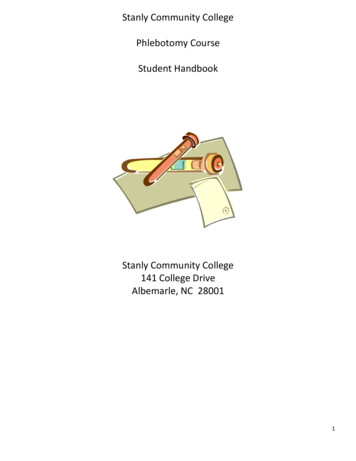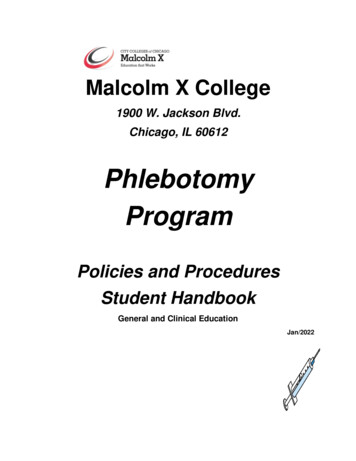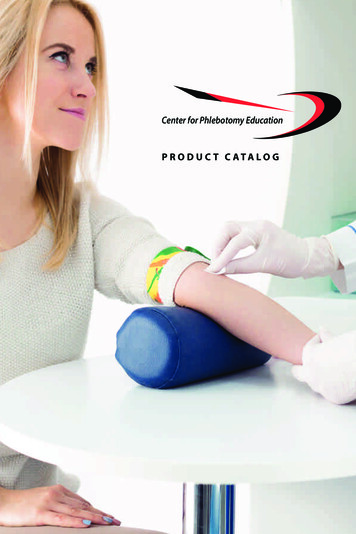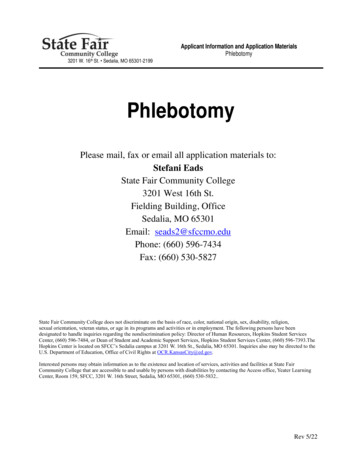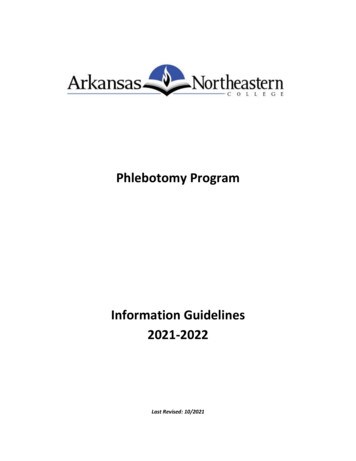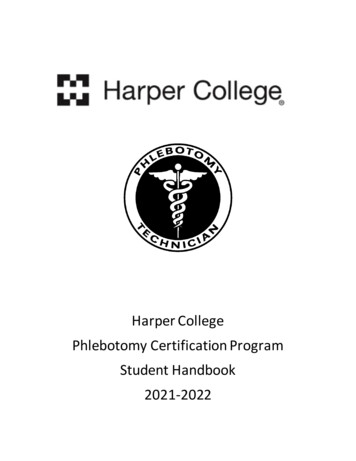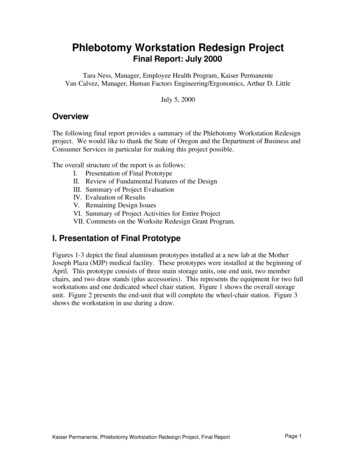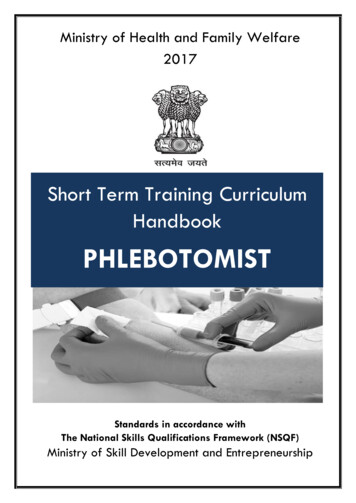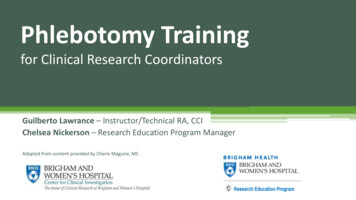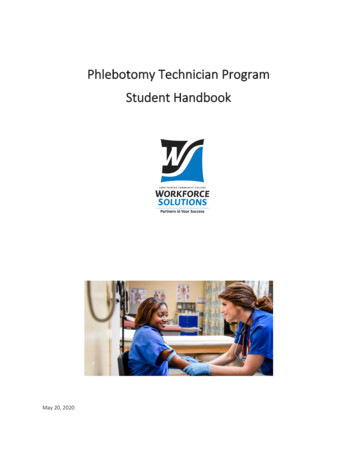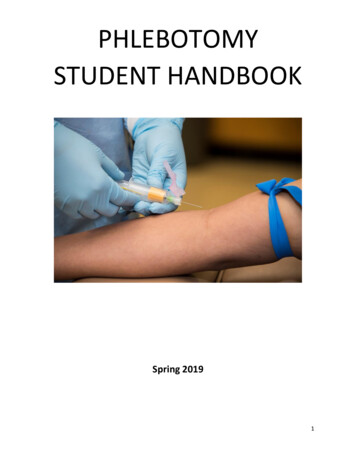
Transcription
PHLEBOTOMYSTUDENT HANDBOOKSpring 20191
Phlebotomy Student HandbookThe policies in this handbook apply to you as a student in the Phlebotomy Program at the CommunityCollege of Philadelphia and at any clinical site that you attend as part of the program. Read this manualcarefully now and as needed during your enrollment in the Phlebotomy Program. It is imperative thatyou are aware of ALL policies, are familiar with them, and adhere to them.DISCLAIMER: The Program policies are subject to change at the discretion of the Program Director andfaculty. Should changes be required, they will not be made capriciously, but for valid and necessaryreasons.2
Table of ContentsPROGRAM OVERVIEW: . 5Phlebotomy Certificate Program description . 5Phlebotomy Program Mission Statement . 5Goals of the Phlebotomy Program . 5Program Standards . 6Performance Standards for Allied Health Programs, MLT and Phlebotomy Programs . 6Essential Requirements for the Phlebotomy Program . 8Acceptable Phlebotomy Proficiencies . 9MLT 102 PHLEBOTOMY .10Student Learning Outcomes .10Professional Standards .11Moral & Ethical Conduct .11Professional Conduct .11E-mail Etiquette .12Social Networking .12Electronic Devices .12ADMISSION .13Phlebotomy Program Entry Requirements: .13Schedule:.14Disciplinary Action .14Reconsideration .15RULES AND REGULATIONS .16GradingCourse component breakdown: Letter grades: .16Inclement Weather .17Policy on Student Service Work .18Withdrawal Policy .18Advising .19Alcohol and Drug Use .19Dismissal from the Program .19Readmission Policy .19Student Records.19Program’s closure policy .203
MLT/Phlebotomy Student Uniform Policy .21MLT Student Lab Safety Plan .22Malpractice/Liability Insurance .23Medical Insurance .23COMMUNITY COLLEGE OF PHILADELPHIA INFECTIOUS AGENT AND BLOODBORNE PATHOGEN EXPOSUREPOLICY MLT and PHLEBOTOMY PROGRAMS .24Injuries/Exposure to Infectious Agents .24MLT Faculty .26Resources and Support Services .27CLINIAL EDUCATION: .28CLINICAL AFFILIATION AGREEMENTS .28Phlebotomy Clinical Sites .29Tips for a Successful Clinical Rotation .30ASCP BOC Certification .31Eligibility Routes for Phlebotomy Technician, PBT(ASCP) .31Appendix A.: Allied Health Department .32Clinical Code of Conduct Report Form .34Appendix B. Community College of Philadelphia MLT and Phlebotomy Programs .36Pregnancy Release Form and Documentation of Pregnancy .36Appendix C. MEMORANDUM: Making a Complaint .37Student Complaint Form .38Appendix D. Infectious Agent and Bloodborne Pathogen Exposure Policy .39Appendix E. Clinical Site Information .40Appendix E: Evaluation forms: .41Phlebotomy Program Student Evaluation .43CCP PHLEBOTOMY PROGRAM STUDENT’S ATTENDANCE RECORD .45CCP PHLEBOTOMY PROGRAM MLT102 VENUPANTURE SHEET .46ATTACHMENT F. ASCP exam Content guide:.474
PROGRAM OVERVIEW:Phlebotomy Certificate Program descriptionMLT 102 - Phlebotomy is a one-semester course that includes two hours of lecture, three hoursof student lab and eight hours of clinical rotation per week in a hospital laboratory oroutpatient facility. The program is approved by the National Accrediting Agency for ClinicalLaboratory Sciences (NAACLS). * Students who successfully complete the program are eligibleto take the PBT (ASCP) Certification exam. * www.naacls.org. This course provides studentsthe skills and knowledge required to work in specimen collection in a healthcare setting.Emphasis is on venipuncture procedures, professionalism, the operation of the clinicallaboratory, and specimen processing. Clinical practice in the laboratories of Philadelphia area isincluded.Phlebotomy Program Mission StatementThe mission of the Phlebotomy Certificate Program of the Community College of Philadelphia isto be an exemplary program graduating highly qualified individuals to fill the employmentneeds of the City of Philadelphia and the Pennsylvania suburban areas. The Program iscommitted to serving students with excellent academic instruction and professional training.The faculty is committed to providing quality instruction by preparing graduates to beemployable at an entry level in phlebotomy and to successfully pass a national certificationexamination in Phlebotomy.Goals of the Phlebotomy ProgramThe Goals of the Phlebotomy Program are that the student:1. Will be accountable as a phlebotomist for the procedures expected of an entry levelphlebotomist.2. Will apply for and take a certification exam in Phlebotomy by an accredited certificationagency.3. will respect the rights of patients, faculty, clinical supervisors, fellow students, and otherhealth professionals and will safeguard confidentiality within the constraints of legal,ethical and moral conduct.4. Will exercise sound judgment, clear thinking and appropriate decision making skillswhile serving the needs of the community and the profession.5. Will practice within the profession’s ethical and legal framework.6. Will continue to maintain professional competence and utilize opportunities forcontinuing education and career advancement.7. Will function as a competent phlebotomist, within the limitations of that role as amember of a healthcare team providing quality health care service.5
Program StandardsPerformance Standards for Allied Health Programs, MLT and PhlebotomyProgramsThe Community College of Philadelphia’s Department of Allied Health has adopted the following CorePerformance Standards for all applicants to the Allied Health degree and certificate programs. Thesestandards are based upon required abilities that are compatible with effective performance in alliedhealth programs. If an applicant is not able to meet the Core Performance Standards, he/she isresponsible to identify his/her inability to perform the required tasks, with or without accommodation.If while in the program, a student fails to meet the Core Performance Standards, with or withoutaccommodation, the student will be removed from the program as the Performance Standards areconsidered Essential Functions for health care professionals.All students are required to meet these performance standards. Allowing for individual differences andencouraging program completion for students with a documented disability, the allied health programswill work with the student and the Center on Disability to provide any reasonable accommodation tomeet these performance standards when The ability to perceive eventsrealistically, to think clearly andrationally, and to functionappropriately and efficiently inroutine and stressful situationsExamples of Activities(Not All Inclusive)Identify changes in patient/clienthealth status.Handle multiple priorities instressful situations and remaincalm.Critical ThinkingCritical thinking ability sufficient forsound clinical judgmentIdentify cause-effect relationshipsin clinical situations. Develop plansof care Respond competently withinscope of practice. Interpret patientcondition and apply appropriateintervention.InterpersonalInterpersonal abilities sufficient tointeract with individuals, families,and groups from a variety of social,emotional, cultural, and intellectualbackgrounds.Establish rapport with patients/clients and colleaguesappropriately. Demonstrate highdegree of patience. Manage avariety of patient/client expressions(anger, fear, hostility) in a calm andprofessional manner. Reactappropriately to constructivecriticism.CommunicationCommunication abilities in Englishsufficient for appropriate interactionwith others in verbal and writtenform.Read, understand, write and speakEnglish competently. Explaintreatment procedures.Initiate health teaching. Documentpatient/client responses. Validate6
responses/messages with others.Obtain medical history accuratelyand document clearly. Read(decode), write, and understand ondemand.MobilityAmbulatory capability to sufficientlymaintain a center of gravity.Ability to ambulate withoutassistive devices in confined areas,reach laboratory benchtops andequipment.Gross and fine motor abilitiessufficient to safely use bloodcollection equipment and labanalyzers.Reach, manipulate, and operateequipment, instruments, andsupplies to include VP needles andmicropipettes.Auditory ability sufficient to monitorand assess, or document healthneeds/information.Hear monitor alarms, emergencysignals, and cries for help. Heartelephone interactions.Hear dictation being given frommultiple directions and whenfacemasks are being used.VisualVisual ability sufficient forobservation and assessmentnecessary in patient/client care, andperform accurate colordiscrimination.Observe patient/client responses.Discriminate color changes.Accurately read measurement onpatient/client related equipment.Visual dexterity with eye/handcoordination.TactileTactile ability sufficient for physicalassessment, inclusive of size, shape,temperature, and texture.Performs palpation.Performs functions of examinationand/or those related to physicaltherapeutic intervention, (e.g.,insertion of a needle) safely andcompetently.The ability to tolerate lengthyperiods of physical activity.Move quickly and/or tolerate longperiods of standing and/or sitting.Perform tasks accurately under timeconstraints.Ability to tolerate environmentalstressors.Adapt to rotating shifts.Work with chemicals anddetergents.Tolerate exposure to fumes andodors.Work in areas that are close andcrowded.Perform with minimal supervision.React quickly to emergencysituations and control emotions.Motor SkillsHearingActivity ToleranceEnvironmental7
Essential Requirements for the PhlebotomyProgramThe accrediting agency (NAACLS) requires that all prospective students review the followingEssential Requirements (Essential Functions) as part of the admission process to thePhlebotomy Program at the Community College of Philadelphia.The Phlebotomy student will be able to:1. Move freely and safely about the laboratory and other work areas.2. Characterize color and clarity of supplies and reagents.3. Reach laboratory bench tops and shelves, patients lying in hospital beds, or patients seatedin specimen collection chairs.4. Travel to various clinical sites for practical experience.5. Maneuver phlebotomy collection equipment to safely collect valid laboratory specimensfrom patients and other students in class*.6. Use a computer keyboard to record and transmit information.7. Follow written and oral instructions to correctly and independently perform the duties of aphlebotomist.8. Clearly instruct patients prior to collecting specimens.9. Communicate with faculty, classmates, staff, patients and other healthcare professionalsverbally and in a written format.10. Be able to adapt to working in a professional environment.11. Be able to adapt to work proficiently in a stressful and/or distracting environment.12. Be able to work with unpleasant biologicals and potentially infectious agents.13. Use safe venipuncture technique and standard precautions to ovoid potential exposure toBlood Borne Pathogens**.14. Be honest, compassionate, ethical and responsible. The student must be forthright abouterrors or uncertainty.*Each student is required to perform multiple venipunctures on a student partner during oncampus labs to gain proficiency before performing it on patients at clinical sites. This alsoentails each student allowing a fellow student partner to perform venipunctures upon themas part of the training process.**Students are required to complete blood born pathogen training on campus beforeperforming a VP. While safe technique and standard precautions are essential both on campusand at clinical rotations, students should be aware that with any healthcare career involving theuse of sharps, there is a risk of accidental needle exposure. Proper technique and proceduresare of the utmost importance and critical at all times to avoid such exposure.8
Acceptable Phlebotomy ProficienciesUpon completion of the Phlebotomy Program, the student should be able to perform100 successful venipunctures under routine work conditions with minimal supervision.This includes:1. Proper identification of the patient.2. Selection of the correct tubes for the tests requested.3. Utilization of the correct procedure for obtaining the patient’s blood: Prepare equipment (tubes, holder, needle, etc.)Tie the tourniquetSelect the appropriate veinClean the sitePuncturing the vein, collecting the required amount of sampleUntying the tourniquetRemoving the needleMixing and labeling tubesChecking the site and bandaging the arm4.5.6.7.Performing capillary punctures (if done at the clinical site)Performing blood cultures (if requested during the rotation)Keep baskets and collection areas well stocked at all timesDemonstrate basic knowledge of basic computer operations in a clinical labsetting8. Distributing blood and other lab specimens to the correct area of the laboratory9. Exhibit appropriate regard for patient’s well being10. Perform duties in a professional manner at all times9
MLT 102 PHLEBOTOMYStudent Learning OutcomesUpon successful completion of this course students will be able to:1. Collect blood samples from patients of all ages using a variety of equipment whilefollowing safety regulations.2. Describe the additives and types of tests performed on the most commonly usedcollection tubes.3. Summarize basic anatomy and physiology of the human body.4. Explain the phlebotomist’s role and demonstrate professionalism in interacting withpatients and other healthcare workers.5. Describe and perform basic lab procedures including routine urinalysis, point of caretesting and the blood donation process.The Ten Commandments of Phlebotomy1. Thou shalt protect thyself from injury.2. Thou shalt identify thy patients.3. Thou shalt puncture the skin at a 15-degree angle.4. Thou shalt glorify the medial vein.5. Thou shalt invert tubes with additives immediately after collection.6. Thou shalt collect specimens only from an acceptable site.7. Thou shalt label specimens at the bedside.8. Thou shalt stretch the skin at the puncture site.9. Thou shalt know when to quit.10. Thou shalt treat all patients as if they were family.10
Professional StandardsMoral & Ethical ConductA student enrolled in the Community College of Philadelphia’s Phlebotomy Program assumes anobligation to conduct himself/herself in a manner compatible with the College’s function as aneducational institution. This includes, but is not limited to, compliance with State and Federallaws. Any violation will result in a student’s immediate dismissal from the Program.Misconduct for which students are subject to discipline and possible dismissal from theProgram includes: Dishonesty, such as cheating, plagiarism, or knowingly furnishing false information tothe College. Forgery, alteration or misuse of College or clinical documents, records or identification. Theft of, or damage to, property of the College or clinical affiliates, or of a member ofthe College community or clinical affiliate personnel, or campus visitor or patient. Unauthorized entry to, or use of, College or clinical affiliate facilities. Unauthorized exposure to radiation of any person without a physician requisition is abreach of ethics and Federal Law and results in immediate dismissal from the Program. Charge of, arrest for, and/or conviction of possession, use or distribution of any narcoticdrug, central nervous system stimulant, hallucinogenic drug or barbiturate. Disorderly conduct or lewd, indecent or obscene conduct or expression on collegeowned or controlled property or within the clinical affiliate facilities. The violation of a patient’s personal privacy, morally or ethically by a student during theperiod of clinical education.The Program Director reserves the right to remove any student from the Program at any time ifsuch action appears to be in the best interest of the Program and the clinical affiliate.Professional ConductProfessionalism is the key to success as a Phlebotomy student and later as an active participantin the Phlebotomy profession. Students must understand the importance of such intangibles aseffective communication, concern for others, ethical conduct, honesty, initiative, empathy,enthusiasm, loyalty, tact, dedication, cooperation, efficiency and professional sophistication.Students are representatives of not only the Program, but also the Community College ofPhiladelphia and affiliate hospitals and clinics. The Program sincerely hopes that studentconduct will bring only compliments. Students are to adhere to the College’s Student Code ofConduct contained in the Appendix A. and the Student Handbook, which is available throughthe Student Life Center located in Room S1-19, the Regional Centers or online at www.ccp.edu.Students must always conduct themselves in a professional manner and maintain the commonlaws of courtesy.The common laws of decency include, but are not limited to:11
Unnecessary talking in class is distracting to faculty and to fellow students. When facultyis responding to the question(s) of student, all students in the class can profit byrefraining from unnecessary talking while the question(s) is/are being answered.Whether in the classroom or in the clinical facility, if a student is dissatisfied with ANYsituation, they may request a conference with the respective faculty and/or ProgramDirector.Loud or boisterous conversation or activity in the classroom, College corridors, or in theclinical facilities is to be avoided.Smoking is prohibited in all College buildings and clinical facilities.Eating is NOT permitted in the College classroom/laboratory and in the laboratory of theclinical facilities.Gum chewing during lab simulations and at the clinical facilities is not professional andwill not be tolerated.College faculty and clinical staff are appropriately referred to as Doctor, Mister, Miss orMrs. and surname.E-mail EtiquetteFaculty will communicate with students via the provided MyCCP and home e-mail account.Students are required to have a working CCP e-mail address for communication purposes andare required to check it on a regular basis. If a student needs assistance and e-mails a facultymember, the e-mail request may be forwarded to an appropriate department or person whocan assist. Students should be reminded that e-mail is not the same as text messaging,abbreviations are not appropriate, and messages should be addressed in a professionalmanner.Social NetworkingStudents should be cognizant of statements, pictures and/or conversations posted on socialnetworking sites. Use of social networking during scheduled classroom or clinical hours isstrictly prohibited. Conversing on these sites regarding classes or clinical education will result indisciplinary action and possible dismissal from the Program.Electronic DevicesUse of electronic devices of any kind is strictly prohibited in the clinical education setting. Alldevices should be turned off and left in the student locker during clinical hours. Students arewelcome to bring laptop computers or tablets to class for academic purposes, howeverstudents found misusing devices during class (e.g. searching the web or posting on socialnetworking sites) will be asked to remove the device and be subject to disciplinary action. Cellphones must be turned off or be set on silent mode during scheduled classroom, laboratory,and clinical assignments. If students have a family concern and would like to leave their cellphone on vibrate, they must notify faculty before class begins and let them know that they mayhave to step out to take an emergency call. Under no circumstances should these devices beused as calculators.12
ADMISSIONPhlebotomy Program Entry Requirements:Admission is selective and requires that potential students fulfill all College admissionrequirements:1.2.3.4.5.High school diploma or general education diploma (GED).Being 18 years of age.English 101 and FNMT 017 placement (do not have to be taken before enrolling in the course).Verification of medical insurance.The student must present the following paperwork before admission to the program:Required clearances:a. Criminal Background Check: Any felony conviction within the past 10 years results in denial of admission to theMLT program.Any felony conviction more than 10 years old will be evaluated based on the nature ofthe offense, length of time since the offense and any explanatory letters/materialssubmitted by the applicant or student.Any misdemeanor will be evaluated based on the nature of the offense, length of timesince the offense, and explanatory letter/materials submitted by the applicant orstudents. (Any punishment over one year indicates a felony according to federalsentencing guidelines.)b. Child Abuse Clearance: Any record results in denial of admission into the MLT program.c. Negative drug screen The MLT program requires participation in clinical education. Some clinical affiliates ofthe MLT program require evidence of a negative drug screening test for a student toparticipate in the clinical part of the clinical laboratory program at their facility.Therefore, any student with a positive drug screening test cannot be admitted into theMLT program.d. Health form*: Health clearance form completed by a health provider proving a copy of proof (printoutof test results) of immunity to Measles, Mumps, Rubella, Varicella, Polio, Hepatitis B,13
Diphtheria/Tetanus; proof of Influenza vaccine (only in the Fall/Spring), Absence of TBby QuantiFERON TB test. Revaccinations must be documented.*Health form and clearances should be no older than 6 months before the classes start.Application process: online registration is not availableApplications along with the instructions for the obtaining clearances will be given at the Alliedhealth office W1-1 starting: First week of April -for Fall semester, First week of October - forSpring semester, Second week of February - for Summer semester. The announcement aboutthe applications release date will be posted on myccp website.Admission will be granted to the students who will submit all the mandatory paperworkbefore the due date on the application (on the first come -first registered basis). The seatsare limited to 24 students for the fall and spring semesters and 12 for summer I. The studentswill be notified via e-mail about acceptance into the program.Schedule:Fall and Spring: One two hour lecture and one 3 hour lab per week, plus one eight hour day atthe clinical site for practice of phlebotomy.Summer I: May – June. Two 2 hour lecture and two 3 hour lab per week, plus two eight hourdays at the clinical site for practice of phlebotomy.Disciplinary ActionInvolvement in any incident which resulted in disciplinary action against a student at theCommunity College of Philadelphia or any post-secondary institution is considered in theadmissions process. The Phlebotomy Program reserves the right to deny admission to anyapplicant who has a documented history of violating College rules and/or regulations or whohas been previously suspended or expelled from the College or any other post-secondaryeducational institution.14
ReconsiderationAn applicant who believes that an error of fact has been made in terms of the informationprovided to the decision-making committee can request reconsideration by the committee.This request must be made in writing within 10 days from the date of the letter notifying theapplicant of the decision. The reconsideration should address what the applicant considers tobe errors of fact. Following reconsideration by
Phlebotomy Program at the Community College of Philadelphia. The Phlebotomy student will be able to: 1. Move freely and safely about the laboratory and other work areas. 2. Characterize color and clarity of supplies and reagents. 3. Reach laboratory bench tops and shelves, patients l
